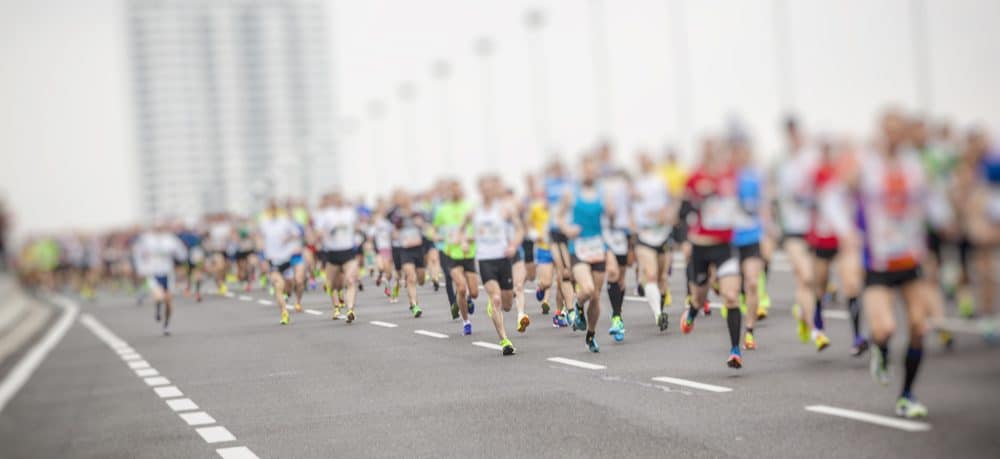Running is a popular type of exercise with amazing health benefits, but it also comes with a risk of injury.
Whether you’re a recreational runner or an experienced runner, understanding injury prevention is crucial for a long and enjoyable running journey.
This means making sure your training plan is smart and takes the repetitive nature of running into account.

Key Takeaways:
- Understanding Risks: Common running injuries, primarily overuse injuries, affect the knees, lower legs, feet, and thighs. More than 80% of running issues arise from repetitive strain.
- Injury Prevention Tips: Incorporate proper warm-ups and cool-downs, including dynamic stretches and static stretching, to enhance flexibility and reduce soreness.
- Strength Training: Focus on functional strength training with leg exercises and core strengthening to prevent muscle tension and improve overall muscle strength.
- Follow the 10% Rule: Increase weekly mileage gradually by no more than 10% to avoid excessive training and reduce the potential for injury increases.
- Listen to Your Body: Be aware of signs of pain, such as shin pain or sharp pain; consider consulting a physical therapist if symptoms persist.
- Recovery is Key: Prioritize rest days, aim for adequate sleep, and utilize tools like foam rollers for muscle recovery to support the muscle repair process.
Understanding the Risks: Common Running Injuries

The risk of injury is real; the annual injury rate for runners can be significant. We are looking at common running injuries, with overuse injuries being a major culprit, often stemming from poor training habits. Running-related injuries affect various areas of the body, with the lower limbs being most prone. More than 80% of running issues are due to repetitive strain!
According to 10 sources, the key areas are the knee, lower leg, foot, and thigh, which are highlighted in 7 sources. Common injuries include things like runner’s knee, IT band syndrome, and shin splints. Also, consider that stress fractures are a serious concern and may need a visit to a sports medicine professional, as highlighted by 7 sources.
Quick Look at Some of These Common Running Injuries

| Injury | What You Might Feel | Contributing Factors |
|---|---|---|
|
Runner’s Knee |
Dull pain around the front of the knee. |
Improper running form, weak muscles, or the wrong running shoes. |
|
IT Band Syndrome |
Pain on the outside of the knee. |
Tight IT band and weak glutes and hip flexors. |
|
Shin Splints |
Pain at the front of the lower legs. |
Overuse, running surface, or poor form. |
|
Plantar Fasciitis |
Heel pain, especially when you wake up. |
Tight calves, foot types, and inadequate support in your running shoes. |
|
Achilles Tendinitis |
Pain above the heel. |
Overdoing it or tight calf muscles. |
|
Stress Fractures |
Aching in a bone that gets worse over time. |
Repeated stress to bones. |
|
Muscle Strains |
Pain in your thigh. |
Sudden movements or muscle fatigue. |
How to Stay Healthy: Smart Training and Injury Prevention

It’s better to prevent than to treat, right? Here are the keys to avoiding running injuries:
- Warm-up and Cool-down: It’s important to include dynamic warm-ups, like leg swings to improve blood flow, and static stretching after runs to reduce muscle soreness. 3 sources mention how important these are to injury prevention.
- Learn more about dynamic warmup routines for outdoor running.
- Strength Training is Key: Building strong muscles is crucial for runners. 5 sources promote this idea. Focus on exercises for the core, hips, and legs. Think planks for core strength, lunges for hips, and leg exercises. Functional strength training can make a big difference. This is an important part of preventative techniques. We are going to need a full upper body routine too, as this supports upright posture. It will help with muscle tension and give the body muscle strength. You can integrate a medicine ball into this routine.
- Check out these runner’s strength exercises.
- Your Running Shoes Matter: Choose running shoes that are appropriate for your foot types. Replace your shoes regularly (every 300-400 miles). Orthotic shoe inserts may also be useful.
Find the best running shoes for beginners.
- The 10% Rule and Weekly Mileage: Don’t increase your weekly mileage by more than 10% each week, a rule of thumb backed by 3 sources. Always listen to your body and reduce your training loads if you feel signs of pain or sore muscles. You may also want to consider a drop-back week (reducing your workout mileage) for adequate recovery.
- Learn about running pace training.
- Rest and Recovery: Proper recovery is vital, as supported by 2 sources! Include rest days. Aim for 7.5-8 hours of sleep per night, as good muscle repair happens during rest. Use foam rollers for muscle soreness to help you recover faster. Consider a bike ride as part of the cross-training.
- Explore running recovery methods.
- Nutrition: Eat well and drink water. This gives you the fuel for your runs!
- Discover long-run nutrition tips.
- Listen to Your Body: Be on the lookout for warning signs like sharp pain, persistent aches, or shin pain. Don’t push through pain. If it is constant, then consider a physical therapist. They can make a huge difference. 2 sources mention that going to a physical therapist can be helpful.
Safety and Other Considerations
- Safe Routes: Run in well-lit and populated areas.
- Visibility: Wear reflective clothing.
- Run with a Buddy: If possible, have someone with you.
- Phone: Always carry your phone.
- Running Surface: Run on soft surfaces whenever possible, and consider varying your running surface. Avoid uneven terrain, as this increases the risk of injury.
- Learn about the impact of running surfaces and injury risk.
Resources and Professional Help
If you experience persistent pain, seek guidance from a physical therapist or a sports medicine physician. They can provide a body scan and tailored advice. Sports medicine experts are a fantastic source of information. They can help manage muscle strains and soft tissue injuries and give medical advice.
The Bottom Line: A Healthy Approach to Running

By addressing things like improper running form, tight muscles, and understanding the importance of adequate recovery and not falling victim to poor training habits, you are on the path to a much safer running journey. Remember, injury prevention is about being proactive and listening to your body. With the right approach, you can enjoy running for many years.
So, go out there and take these steps to avoid common overuse injuries by being aware of the potential for injury increases by increasing weekly mileage too fast. If you have muscle tension or muscle fatigue, consider taking a break. Sports medicine experts will help you along the way.
References:
1. Running Injuries: 8 Most Common Injuries, Symptoms, Prevention – Healthline, accessed on January 4, 2025, https://www.healthline.com/health/running-injuries
2. Common Running Injuries and How to Prevent Them | Brown University Health, accessed on January 4, 2025, https://www.brownhealth.org/be-well/common-running-injuries-and-how-prevent-them
3. Common Leg Injuries of Long-Distance Runners: Anatomical and Biomechanical Approach, accessed on January 4, 2025, https://pmc.ncbi.nlm.nih.gov/articles/PMC3497945/
4. Running and jogging – preventing injury – Better Health Channel, accessed on January 4, 2025, https://www.betterhealth.vic.gov.au/health/healthyliving/running-and-jogging-preventing-injury
5. Want to become a better runner? Tips to step up your performance, prevent injuries, accessed on January 4, 2025, https://www.mayoclinichealthsystem.org/hometown-health/speaking-of-health/how-can-i-become-a-better-runner-and-avoid-injury
6. Prevent Common Running Injuries with a Healthy Training Routine | Children’s Hospital of Philadelphia, accessed on January 4, 2025, https://www.chop.edu/news/health-tip/ready-set-run
7. Running Injuries: The Ultimate Runner’s Guide to Injury Prevention – Strength Running, accessed on January 4, 2025, https://strengthrunning.com/running-injuries/
8. Sports Injury Prevention | Running – Boston Children’s Hospital, accessed on January 4, 2025, https://www.childrenshospital.org/sports-injury-prevention/running
9. jeffersonhealthcare.org, accessed on January 4, 2025, https://jeffersonhealthcare.org/news/advanced-running/#:~:text=To%20avoid%20injuries%20during%20training,10%25%20each%20week%20during%20training.
10. Increase mileage while running Gradually To avoid injury – STOVER PT, accessed on January 4, 2025, https://stoverpt.com/increase-mileage-running/
11. How to Prevent Running Injuries while Increasing Mileage – rUnladylike, accessed on January 4, 2025, https://www.runladylike.com/2014/10/29/12-tips-to-prevent-running-injuries/
12. Why Rest and Recovery is Essential in Preventing Overuse Injuries | VOSCT, accessed on January 4, 2025, https://vosct.com/why-rest-and-recovery-is-essential-in-preventing-overuse-injuries/
13. Injury Prevention and Recovery Techniques for Active Individuals, accessed on January 4, 2025, https://profizix.com/injury-prevention-and-recovery-techniques-for-active-individuals/
14. levermovement.com, accessed on January 4, 2025, https://levermovement.com/blogs/journal/5-signs-you-might-be-on-the-verge-of-an-injury-and-how-to-prevent-it
15. Running Injuries: Signs & What To Watch For | The Jackson Clinics, accessed on January 4, 2025, https://thejacksonclinics.com/how-do-i-know-if-i-have-a-running-injury/
16. 10 Common Running Injuries and Why They Occur – Summa Health, accessed on January 4, 2025, https://www.summahealth.org/flourish/entries/2023/06/10-common-running-injuries-and-why-they-occur
17. Tips for a Safe Running Program – OrthoInfo – AAOS, accessed on January 4, 2025, https://orthoinfo.aaos.org/en/staying-healthy/tips-for-a-safe-running-program/
18. Injury Prevention Program – Strength Running, accessed on January 4, 2025, https://strengthrunning.com/injury-prevention-program/
19. Injury Prevention/Stretching – HARTFORD MARATHON FOUNDATION, accessed on January 4, 2025, https://www.hartfordmarathon.com/supporthub/injury-prevention-stretching/
As a veteran fitness technology innovator and the founder of GearUpToFit.com, Alex Papaioannou stands at the intersection of health science and artificial intelligence. With over a decade of specialized experience in digital wellness solutions, he’s transforming how people approach their fitness journey through data-driven methodologies.
